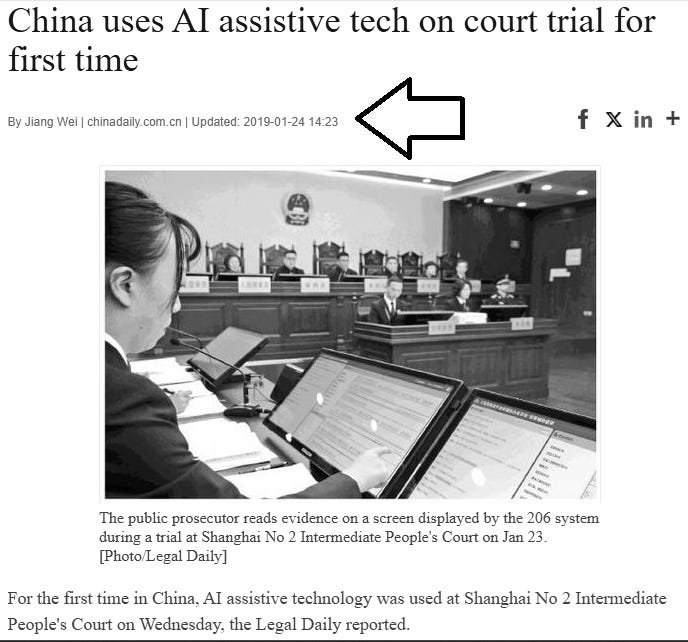China The "206" System AKA Shanghai AI-Assisted Criminal Case Handling System
In China, AI for Law is a State Affair
It may come as no surprise to you that in the Law context, China has levered AI as a State resource/initiative. It did so early, publicly in 2019 with accounts of its use as early as 2016.
Shanghai’s “206” System stands out as the most prominent AI-assisted legal system in China, particularly in the judicial domain, due to its widespread use, government backing, and advanced capabilities in criminal case handling.
Here, a detailed examination of the “206” System, its significance, and a brief comparison with other notable AI legal tools in China:
Shanghai’s “206” System
Officially known as the Shanghai AI-Assisted Criminal Case Handling System.
Recognized as China’s leading AI-assisted platform for legal adjudication, particularly in criminal proceedings.
Launched as a pilot program and now fully implemented in Shanghai, it is supported by the Central Political and Legal Affairs Commission and involves collaboration among the Shanghai High Court, public security bureau, procuratorate, bureau of justice, and iFLYTEK, a world-leading AI solution provider.
What is iFLYTEK?
iFLYTEK is the leading Chinese technology company specializing in artificial intelligence (AI), particularly in speech recognition, natural language processing (NLP), voice synthesis, and machine learning.
Founded in 1999 and headquartered in Hefei, Anhui Province, iFLYTEK is a publicly listed company on the Shenzhen Stock Exchange (stock code: 002230) and is recognized as a global leader in intelligent speech and AI technologies.
It plays a significant role in China’s AI ecosystem, with applications across multiple sectors, including legal, education, healthcare, automotive, and smart cities.
“206” System’s Key Features:
Similar Case Recommendation (SCR): The system analyzes case data and prior judgments to recommend similar cases, ensuring consistency in sentencing and judicial decisions across regions. This addresses China’s challenge of maintaining uniform penalties nationwide.
Evidence Collection and Case Analysis: Assists prosecutors and judges by processing vast amounts of case data, identifying relevant evidence, and providing predictive analytics for case outcomes.
Document Review and Transcription: Automates rote tasks like transcription and legal document analysis, improving efficiency in judicial workflows.
Multi-Agency Integration: Connects police, prosecutors, and judges, enabling seamless data sharing and case management across Shanghai’s criminal justice system.
Big Data and AI Algorithms: Leverages big data, machine learning, and natural language processing (NLP) to enhance decision-making accuracy and speed.
Impact and Adoption:
Mandatory Use: All pending criminal cases in Shanghai are processed through the “206” System, with front-line legal practitioners (police, prosecutors, judges) required to use its features, particularly SCR.
Efficiency Gains: The system has significantly reduced case handling times. For example, it enables complex cases (e.g., multiple loan default trials) to be resolved in a single hearing, as seen in the Xiao Zhi 3.0 assistant program used in Hangzhou’s AI court.
National Model: As part of China’s “Smart Justice” initiative (launched in 2016), the “206” System is a flagship project, influencing other regions to adopt similar AI tools. Its success has spurred the Supreme People’s Court to mandate AI integration in judicial practice nationwide since December 2022.
Challenges and Criticisms:
Anchoring Effects: The system’s recommendations may overly influence judicial decisions, potentially reinforcing biases or limiting judicial discretion. Anchoring is that human predilection to rely upon prior especially “authoritative” information. In other words if 206 says a person is guilty, humans will most likely view them as guilty.
Transparency: The algorithms’ “black box” nature raises concerns about accountability and the accuracy of outputs, especially in complex cases.
Ethical Concerns: Automating judicial processes risks compressing defendants’ procedural participation and encouraging accountability avoidance among judicial officers. Critics, like Zhiyu Li (Durham University), highlight ethical issues when AI decisions are perceived as more credible than human judgments.
Data Bias: The system relies on judicial data from platforms like China Judgments Online, but controversial cases have been removed due to public criticism, raising concerns about biased or incomplete data sets affecting AI decisions.
Other Notable AI for Law Platforms in China
While the “206” System leads in judicial applications, other AI tools are significant in specific legal domains:
Xiao Zhi 3.0 (“Little Wisdom”)
Description: Used in Hangzhou’s AI-based Internet Court (launched 2019), this judicial assistant program streamlines small claims and e-commerce disputes. It evaluates evidence, applies legal standards, and supports videoconference hearings.
Significance: Resolved 10 loan default cases in one 30-minute hearing, showcasing efficiency. However, it’s limited to simpler civil cases compared to the “206” System’s criminal focus.
Challenges: Concerns about reliability for nuanced cases and potential erosion of judicial power by AI companies.
Xiao Baogong Intelligent Sentencing Prediction System
Description: An AI platform used by judges and prosecutors in criminal law to suggest penalties based on big data analysis of case information and prior judgments.
What about AI for Criminal DEFENSE?
As of April 2025, there is no publicly documented AI tool in China explicitly designed and widely recognized for criminal defense purposes, comparable to judicial or prosecutorial tools like the Shanghai “206” System or the AI Prosecutor developed by the Shanghai Pudong People’s Procuratorate.





